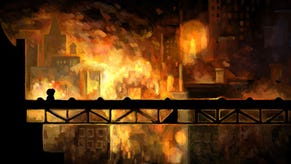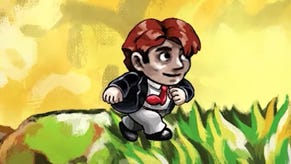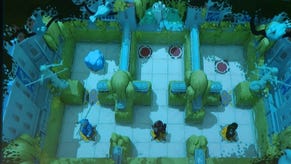Braid
Everything changes.
This is perhaps the nineteenth time I've started writing this review. If this were a montage in an old movie, this is the point we'd cut to the bin next to my desk, overflowing with crumpled balls of paper, torn in frustration from an imposing, mocking typewriter. Braid has filled my head with so many ideas, so many opinions, so many emotions that wrestling them all into a coherent critique is like trying to strangle a swan made of jelly. Every time I think I've found a mental strand that leads to the natural start of the review, it unravels. I've gone to bed thinking about Braid, and I've woken up thinking about it. From the fragments I remember, I'm pretty sure I've dreamed about it as well.
Braid is that sort of game.
Boiled down to its barest essence, it's a platform game where you must travel through six worlds to find and assemble jigsaws. Control is of the basic left-right-jump variety, and levels are made up of ladders, floating platforms and cannons that spit out whimsical enemies, deadly to the touch unless you jump on their head. The twist is that you now have control over time, and holding down the X button rewinds everything you've done. Time and its manipulation, not jumping, is the overriding gameplay feature.
Even though Braid takes obvious influence from Super Mario Bros, its creative importance reminds me most of Alan Moore and Dave Gibbons' seminal graphic novel, Watchmen. On one level, it's exactly what it appears to be. For Watchmen, a superhero murder mystery. For Braid, a 2D platform game. But there's more. Much more. Both are works of homage and deconstruction, commentaries on the way we interact with their respective media. The deeper you look, the more you see.
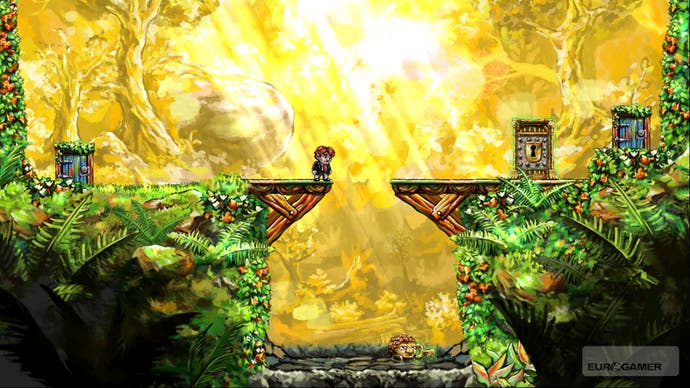
More than that, it's something that could only be done in this medium. Watchmen was written and drawn to explore narrative ideas that could only work in sequential panels and word balloons. Braid does much the same for jumps, moving platforms and perambulating enemies. So many games try to justify their creative ambitions by cribbing from other forms - wannabe movies dressed up as games, relying on our rehearsed responses from non-gaming experience. Braid is a videogame. It could only be a videogame and therein lies its true genius.
At this point, I suspect I'll have lost a lot of you. Understandably wary of artistic pretension in games, and heartily sick of videogame reviewers indulging their frustrated poetic tendencies, you'll see just another low-budget platform game lavished with praise by jaded critics just because of its indie roots. You'll see a clichéd story being praised for its emotional depth. You'll see the time manipulation being praised as an act of remarkable design innovation, and you'll scoff at how Blinx, Prince of Persia and TimeShift all did it first. On all fronts, you'll be wrong.
Other games may have offered rewind mechanisms, but always as a peripheral feature firmly within an otherwise rigid gameworld. Like bullet-time in The Matrix, it was a cool visual effect but with limited impact on the core gameplay beyond saving your life. In Braid, being able to rewind your death and try again is entry-level stuff. That's the basics, the launch pad, the minimum that the concept allows you to do. Here it's more than just a limited second-chance mechanism. Not only can you rewind all the way back to the start of the level, undoing everything you did, but doing so is often essential to progress. You must look back to go forwards.
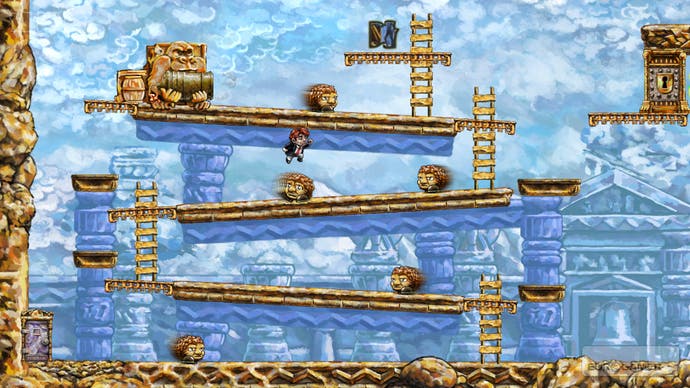
The game soon introduces magical items - identified by a green glow - which exist independently of your timestream. In other words, when you rewind time, whatever you do to these items is not undone. The most basic example, and the one the game uses to introduce the concept, is that you can drop into an inescapable pit to grab a magical key. You can then rewind time to return yourself back to the moment before you jumped in, except you're still holding the key. Doors, platforms and even enemies can be subject to this effect, and once you get past the ingrained notion that success must come only from linear leaps, and embrace the idea that you can set things up in the future before rewinding to the past for the payoff, it's as if years of gaming blinkers have been ripped away.
And still there's more. The game never plateaus, never stops adding even more wrinkles to its temporal mischief, crafting puzzles that stretch your mind and force you to re-evaluate every assumption you ever held about how games can work. By the time you complete World 3, you'll have solved intricately brilliant puzzles that would be the design highlight of most games, yet each world has its own unique way of handling the flow of time. In World 4 time flows depending on your movements. Move right and time flows forwards. Move left and it flows backwards. There's a level based on Donkey Kong, called Jumpman, which uses this idea quite brilliantly - taking the left-to-right-to-left ascent of the arcade classic and turning it into something entirely mind-boggling.


